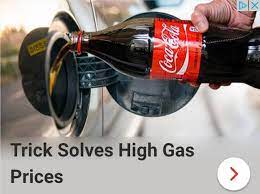Gadget Daddy: Simple trick to lowering fool consumption - avoid clickbait


Perhaps you have seen the ad on the Internet: A Coca-Cola bottle is being tipped up to a car's gas tank. The ad copy says, "Simple Trick to Lower Car Fuel Consumption by 55%."
One commenter posted about a similar ad, "Going out on a limb here, but I'm pretty sure that pouring ketchup into your gas tank will reduce your fuel consumption by 100%." Ditto for Coca-Cola.
To prove that point, a YouTuber who purchased a BMW E46 for about $1,000 poured two liters of Coke into the car's gas tank, then cranked it up and drove away.
The video can be found at this link: www.tinyurl.com/CokeAsGas. It has been viewed more than 12.6 million times since it was posted in late 2017.
Within 60 seconds with the new fuel mix, he was asking, "What's that noise?" and then, "The car's stalling." The bill to fix the car was more than $1,600, "and the car only cost me $1,000."
Clicking on the "Coke as a fuel additive" ad leads to a web page for a product that plugs into the car's computer port (the "On-Board Diagnostic" port, or OBD, located under the steering column in automobiles). The port is designed mainly for testing purposes, allowing mechanics to plug in computers to test engines and read results.
The plug-in device is advertised to reset the car's computer-controlled fuel ration, thus increasing gas mileage. And here's a problem: There are plenty of websites that point out the OBD is an output port — meaning it doesn't accept incoming signals.
The web page advertising this gas saver claims a 55% fuel saving, but it has no mention of using Coke as a gasoline additive. Why, then, is it pictured in the original ad to lower fuel consumption?
READ MORE FROM GADGET DADDY:
Apple offers $20M in 7-year-old iPhone 4S lawsuit. But is the end really near?
Postal Service's Informed Delivery - you shoulda seen that coming
Netflix is testing a change to account sharing, but not in US - yet
Because the ad is "clickbait" — designed to bait the viewer into clicking on it. Those readers old enough to pre-date the Internet probably know this practice as "bait-and-switch." The term "clickbait" first came into use in 1999, according to Merriam-Webster, and was officially added to the dictionary in 2015.
Wikipedia defines it as a practice "designed to attract attention and to entice users to follow that link and read, view, or listen to the linked piece of online content, being typically deceptive, sensationalized, or otherwise misleading."
Other instances of this clickbait ad show different things being added to the gas tank, including dishwasher tablets, ketchup and toothpaste. Snopes, an online site devoted to debunking urban legends, advised: "Off the top, we strongly advise against putting anything in a car’s fuel tank other than gasoline."
The name of the product isn't mentioned here because the focus has been on clickbait — the method employed to get users to click on the ad in the first place.
Merriam-Webster defines clickbait as something "designed to make readers want to click on a hyperlink, especially when the link leads to content of dubious value or interest."

Whether the item being advertised is of "dubious value or interest" is for the person clicking on the link to decide. Just be aware that there's likely a hook in there somewhere.
Lonnie Brown can be reached at LedgerDatatbase@aol.com.
This article originally appeared on The Ledger: Why does clickbait, which has been around since the 1990s, still work?
